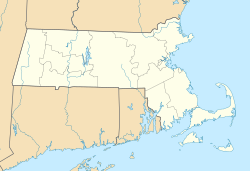Gilman Coggin House | |
 | |
| Location | 123 Prescott Street, Reading, Massachusetts |
|---|---|
| Coordinates | 42°31′6.72″N71°6′53.15″W / 42.5185333°N 71.1147639°W |
| Built | 1847 |
| Architectural style | Greek Revival |
| MPS | Reading MRA |
| NRHP reference No. | 84002551 [1] |
| Added to NRHP | July 19, 1984 |
The Gilman Coggin House is a historic house in Reading, Massachusetts. The 2+1⁄2-story wood-frame house is a fine well preserved local example of Greek Revival architecture. It was built in 1847 by Gilman Coggin, owner of a local shoe-manufacturing business. The house's front gable is fully pedimented, supported by wide corner pilasters. A single-story wraparound porch has square Ionic columns, and the front door surround is flanked by half-length sidelight windows and topped by a fanlight transom. [2]
The house was listed on the National Register of Historic Places in 1984. [1]


